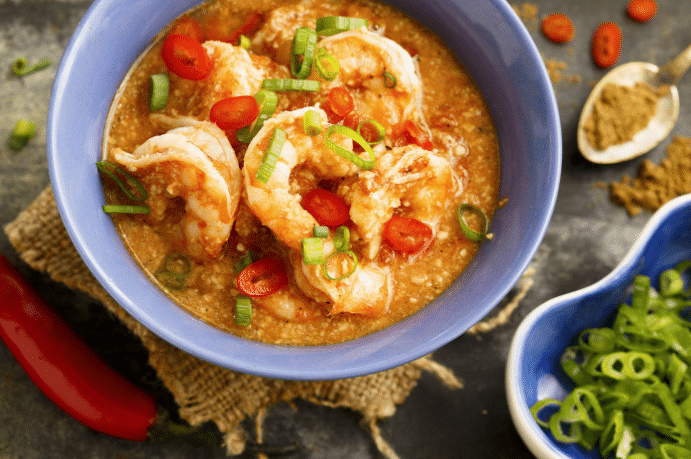If you enjoy sweet coconut milk, juicy shrimp, rainbow veggies, and a spicy sauce, then you need to make Dr. Mark Hyman’s Coconut Curry Shrimp. This healthy, protein-packed meal is a perfect choice for lunch or dinner, you can easily customize this dish to accommodate preferences and dietary restrictions without sacrificing taste. This savory coconut curry shrimp will be a new favorite dish.
What is Curry?
Curry is an Indian dish that is not only traditional to southern Asia, but common all across the world. Over hundreds of years, curry has changed and evolved into what we find at most Indian restaurants today.
While the word “curry” evokes the idea of warmth and earthy spices with just a bit of kick, “curry” itself doesn’t describe a specific flavor. Instead, “curry” means sauce. This means that different types of curry can utilize a variety of different flavors, spice levels, and herbs, providing a large variety of different types of curry.
The variety of types of curry makes it a versatile dish. Depending on the sauce, you can serve it with chicken or shrimp. You can easily change out the types of vegetables you use in the dish to accommodate preferences. You can swap out the traditional rice base if you’d like—after all, “curry” means sauce.
Dr. Mark Hyman’s Coconut Curry Shrimp
Overview
Time: 45 mins
Serves: 4
Perfect for: Lunch or Dinner
Benefits: Offers Healthy Fats, and Vegetables.

What Spices Make Up Curry Powder?
Even though “curry” doesn’t mean a specific flavor, many home cooks use a pre-packaged spice mix called “curry powder.” This combination contains a standard variety of spices that are traditionally used in many curry dishes. Typical curry powder generally includes turmeric, cumin, ginger, and black pepper. Some varieties can also include garlic and cinnamon.
One of the most commonly consumed spices in the world, ginger, has been used as herbal medicine for thousands of years. Recent studies have examined how ginger’s properties can help those suffering from pain and inflammation. Right now, ginger is commonly known to help those suffering from nausea and other gastrointestinal issues.
Another common spice in curry powder is turmeric, which gives curry its yellow or orange color. Turmeric is a member of the ginger plant family and has been used in traditional herbal medicine in Eastern Asia for thousands of years. Even today, it is a supplement used to help with digestion issues, depression, arthritis, and more.
Dr. Mark Hyman’s recipe is guaranteed to be your new favorite to spice up your week.
Ingredients
Sauce:
- ¾ cup raw cashews
- ¾ cup hot filtered water
- 1 ¼ cups canned full-fat coconut milk (about three-quarters of a 14-ounce can. Combine well before measuring).
- 1 (1/2- 1-inch) piece fresh ginger, peeled and cut into ¼-inch rounds
- 1 small clove garlic
- 1 ½-2 tablespoons curry powder (or more, to taste)
- Red pepper flakes (optional)
- 1 teaspoon salt
Shrimp:
- 1 teaspoon avocado oil
- 1 ½ pounds medium shrimp, peeled and deveined
- ¼ teaspoon salt
- 2 medium carrots (about 1 cup), cut into matchsticks or coarsely shredded
- ½ red bell pepper, cored, seeded and diced
- 2 cups shredded cabbage
- ¾ to 1 pound snow peas or snap peas (30-40 pods)
- 2 ½ cups prepared coconut curry sauce
- ½ cup chopped fresh cilantro
- Curry powder, to taste
- 3 cups (packed) spinach, chopped
Cooking Instructions
Step 1
To make the coconut curry sauce, place all the ingredients for the sauce in a high-speed blender. Blend until smooth. You can also use an immersion blender and a large mason jar or deep bowl. With an immersion blender, work the blender into the thicker pieces of vegetables and nuts until they are smooth and creamy.
Step 2
Heat oil in a large skillet or pot over medium heat. Add shrimp and sprinkle with the salt. Sauté until the shrimp are pink on all sides, about 3 to 5 minutes.
Step 3
Stir in the carrots, bell pepper, cabbage, snow peas, and coconut curry sauce. Bring to a boil, and then reduce the heat to medium-low. Cover and simmer, frequently stirring, until the vegetables are tender but still bright and the sauce has thickened 5 to 7 minutes. Adjust the seasoning with more curry powder or salt as needed. Stir in the cilantro.
Step 4
Spread the spinach on a serving tray or divide it among individual bowls. Place the hot vegetable curry mixture on top of the spinach. The spinach should begin to wilt under the heat of the sauce. Serve immediately while the vegetables are still bright.
We hope you enjoy this recipe and continue learning with us about the incredible powers of healthy food and overall wellness.
Looking For More Guidance On Nutrition and Food?
Our Latest Blogs
-

Student Spotlight: Sonja Brink
Read Full Article: Student Spotlight: Sonja Brink -

Alumni Spotlight: Angela Balboa
Read Full Article: Alumni Spotlight: Angela Balboa -

FMCA Community Impact Scholarship Recipients For March 2026 Announced
Read Full Article: FMCA Community Impact Scholarship Recipients For March 2026 Announced
